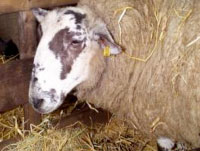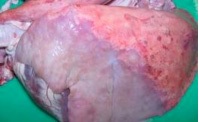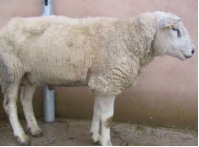Pneumonia in adult sheep: NADIS sheep health bulletin

Pneumonia is often over-diagnosed in adult sheep simply because the animal presents with an increased respiratory rate and breathing effort despite the fact that many infections affecting other organ systems can present with such signs including mastitis, metritis, clostridial diseases, painful lesions/severe lameness, acute fasciolosis and hypocalcaemia.
If treated for respiratory disease, these sheep die, reinforcing the myth that sheep do not respond well to treatments when the actual problem is one of mis-diagnosis
There are three common causes of respiratory disease in adult sheep; respiratory disease caused by Mannheimia haemolytica, sheep pulmonary adenomatosis (SPA), and suppurative pneumonia/lung abscesses. Sheep pulmonary adenomatosis may cause up to 5% mortality with an equal number of adult sheep culled annually because of poor body condition.
Pasteurellosis
 |
|---|
Fig 1: The clinical signs of pasteurellosis include acute onset depression, lethargy and inappetance but these findings could be caused by many other diseases. |
Mannheimia haemolytica causes pneumonia (“pasteurellosis”) in adult sheep, and mastitis in ewes.
The clinical signs include acute onset depression, lethargy and inappetance similar to those features highlighted in Fig 1. Affected sheep separate from the remainder of the flock and are easily caught and restrained. They may show rapid abdominal breathing.
Diagnosis is based on clinical signs but there is no confirmatory test in the living sheep. Confirmation of diagnosis is made at postmortem with histopathological examination of lung lesions, and possibly bacteriological culture from untreated sheep.
While vaccines are available against pasteurellosis in adult sheep, there is often a predisposing factor to this disease such as SPA so that any advantages of vaccination should be carefully considered in the veterinary flock health plan. It may prove more worthwhile to address the initiating cause.
Sheep pulmonary adenomatosis (Jaagsiekte,ovine pulmonary adenocarcinoma)
 |
|---|
Fig 2: Sheep pulmonary adenomatosis is a contagious virus-induced tumour of the lungs (grey/blue areas of the lungs to the left; normal lung is pink to the right). |
Sheep pulmonary adenomatosis is a contagious virus-induced tumour of the lungs of sheep (Fig 2). Disease transmission is accellerated by close confinement and during feeding and has presented a significant problem in some flocks where sheep are housed for long periods during the winter months (Fig 3).
The incubation in naturally infected sheep is many months to several years with clinical disease apparent in two to four year-old sheep. Occasionally, disease is seen in lambs 8 to 12 month-old which are generally the progeny of infected ewes. Early signs include loss of condition, a markedly increased respiratory rate and panting after gathering. A soft cough is often heard and and a scant serous nasal discharge which may eventually become a clear frothy fluid flowing freely from both nostrils. Death may be quite rapid when secondary infection with M. haemolytica occurs.
- SPA can only be diagnosed by post-mortem. Solid grey tumours involving up to 50% of the lungs may be found (Fig 2).
- There is no treatment for SPA and affected sheep must be culled as soon as suspicions are raised.
- Disease is introduced into flocks by purchased infected sheep which shed virus before illness becomes obvious. The main route of infection is by respiratory aerosol.
- Regular flock inspection with prompt isolation and culling of lean and/or dyspnoeic sheep may identify early clinical cases and slow the spread of infection.
- Maintaining sheep in single age groups to prevent infection passing from older to younger sheep is the most important method of control in an infected flock
- Feeding concentrates as large cubes on a clean area of pasture is preferable to trough feeding.
- The offspring of affected sheep frequently develop SPA and must not be kept as replacement breeding stock.
- Prevention can be effected by maintained a closed disease-free flock with double ring fencing.
- Purchase of breeding replacement stock is the major risk factor as there is no blood test for SPA .
 |
|---|
Fig 3: Lung abscesses are not uncommon in adult sheep, especially terminal sire breed rams but are difficult to diagnose on clinical examination alone. |
Suppurative pneumonia/lung abscesses
Lung abscesses are not uncommon in adult sheep, especially terminal sire breed rams (Fig 3 ), but are difficult to diagnose on clinical examination alone. Management of these stud rams, with long housing periods as young lambs and as ram lambs during their first winter predisposes them to various respiratory tract infections which become super-infected with bacteria.
Affected sheep present with a history of poor body condition and are often dull and depressed although appetite may appear normal. At rest affected sheep have a faster breathing rate and cough frequently with occasionally a scant mucopurulent nasal discharge. Diagnosis and treatment are based upon veterinary examination. The treatment response can be very good and the financial value of the ram fully justifies veterinary involvement.
Comments made in this paper are based on the practical clinical experiences of the author working in the field and opinions expressed are derived from those experiences; others may have different experiences.
Copyright © NADIS 2009
NADIS is sponsored by EBLEX, HCC, QMS, Merial Animal Health
SUPPORTING BRITISH LIVESTOCK
